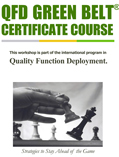"Drunk With Power," an October 14, 2012 New York Times article by Daniel Duane, describes an on-line wine seller named Jon Rimmerman Jon, who earned his retail cred while at Starbucks. Jon summarizes it as this:
“the beauty of retail marketing … can be roughly translated as defining a crystal-clear brand identity and then ensuring that everything from the product to customer relations reinforces it."
I like his words, and would like to give them a QFD flavor.
The purpose of modern
Blitz QFD® is to define and prioritize with crystal clarity, that which is most important to the customer, and then ensure that everything from the product to customer relations reinforces it.
Let me explain.
"Crystal clarity" of what matters most to customers. In
QFD, this means having a customer need that truly states the value proposition to the customer. Typically, this is the benefit a customer receives from having a problem solved, an opportunity enabled, or image enhanced. It should be independent of the product, its features, and its technology. A Voice of Customer (VOC) statement such as "fits in my pocket" is not a customer need, but rather a fuzzy set of dimensions.
With the
Customer Voice table, a Blitz QFD
® tool, you can translate that into true customer needs such as "I can carry with me easily," "Easy to store in my pocket," "Easy to retrieve from my pocket," "Stays in my pocket when I move around," "Does not damage my pocket," etc. This helps us understand these true benefits and avoid later design mistakes resulting in "the product falling on floor when I lean over," "the product tearing my pocket off," "the product is too hard to remove from my pocket when I want to get it out quickly," etc.
Crystal clarity means the need statement must be at a sufficient level of detail to be actionable in design, which is typically a tertiary level on a customer needs hierarchy. Abstract expressions such as "convenient" should be deployed to more detail.
Crystal clarity also means that we have accurate priority values. The QFD community replaced the 1960s' ordinal scale weights with
AHP-derived ratio scale weights in the mid-1980s, first in Japan and then later in the US. Unfortunately, most English language QFD books and articles were written before this and missed the update. Even today, new QFD texts still cite these early works, and continue the math errors resulting from using ordinal weights in both customer needs and matrix relationships, as well as misuse of matrices including using a
House of Quality matrix (HOQ) when it is not needed.
This is why the QFD Institute Green Belt
® and Black Belt
® courses are strongly recommended for professionals in product/service/business development, marketing, design, sigma/lean/DMAIC black belts and so forth. You will learn how to use the modern AHP approach and we provide updated Excel templates. Without AHP clarity, your limited resources risk missing what is truly important and deploying lower priority things.
"Ensuring that everything from product to customer relations reinforces it" is the QFD call for end-to-end quality assurance. Depending on your industry, product, and company, this will vary, but typically describes, end-to-end, the full development, commercialization, and retirement of the product, service, or software. In other words, we must assure that any weakness related to the most important customer needs are made robust. For example, if poor packaging compromises the sterility of a medical supply item, it becomes scrap (let's hope!), wastes money, ruins reputations, could result in injury or death, etc., no matter how well the function and performance of the item was designed.
In classical QFD, each of the design, develop, test, procure, produce, assemble, package, ship, store, sell, support, and other commercialization dimensions has its own matrix. Since the matrix only compares two dimensions at at time, anywhere from four to thirty matrices have been identified in the literature. Maybe in the 1960s-80s, we had enough time and people to analyze these, but that is difficult these days.
In Blitz QFD
®, all these matrices have been replaced for the most part by a single
Maximum Value table. One tool goes end-to-end through all the dimensions. How do we do it – with crystal clarity focus on what matters most to customers. This is where we apply our best efforts, first. Makes sense, doesn't it? The Maximum Value table is one of the key tools taught in the
QFD Green Belt® Course and
QFD Black Belt® Course.
Additional training dates will be published at
QFD Training & Events Calendar as they become confirmed. Or you can
e-mail to us.







